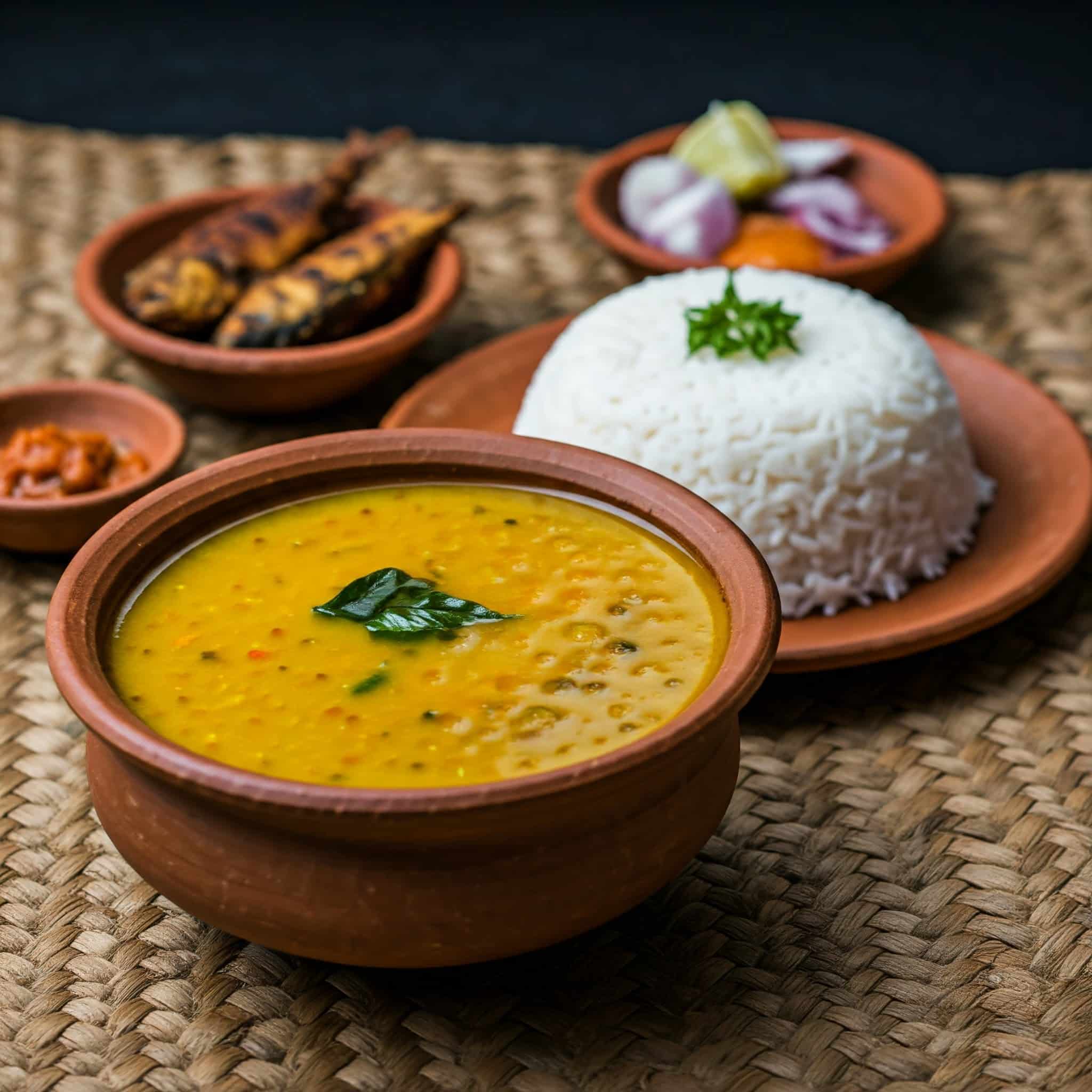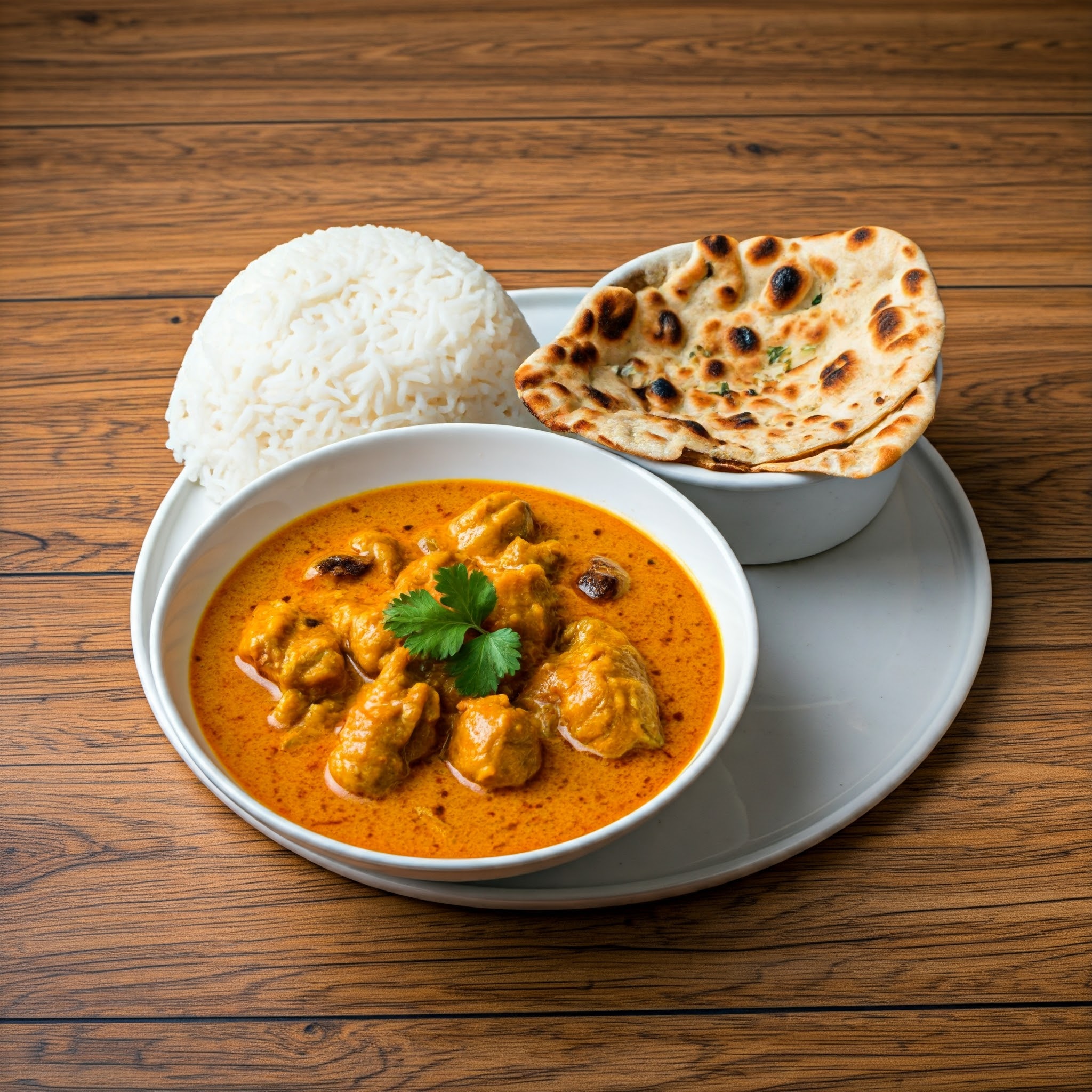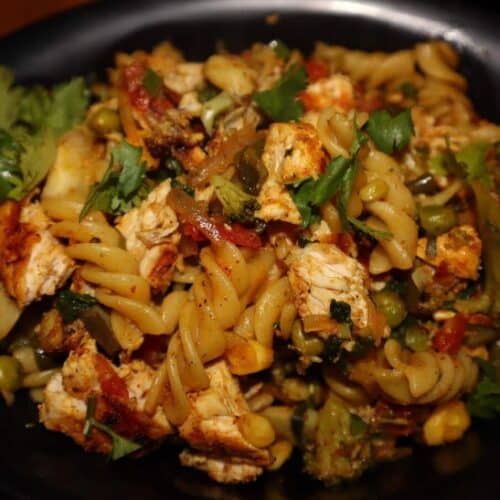Bengali cuisine, originating from West Bengal and Bangladesh, is famous for its distinctive blend of flavours and ingredients. Rich, varied, and utterly satisfying, this cuisine celebrates the region’s vibrant culinary heritage in a big way. Understandably, a Bengali lunch isn’t just a meal—it’s an event. A symphony of subtle yet spicy flavours married in perfect concert, it offers diners a delightful journey through various textures and tastes. Every dish, from the starters to desserts, has its unique charm. Whether you’re a local, a traveller, or a food enthusiast, a Bengali lunch is an authentic gastronomic adventure that leaves a lasting imprint on your palate.
Must-Try Bengali Lunch Menus
Let’s delve deep into the alluring world of Bengali food, featuring an incredible range of dishes, each unique in its taste and preparation. Our Bengali lunch menu lists a combination of vegetarian delicacies and non-vegetarian delights paired with sensational accompaniments and lip-smacking desserts. Each dish carries the unique aroma of mustard oil and is enriched with poppy seeds, offering a taste that lingers long after you’ve finished your meal.
Starters
In Bengali cuisine, starters play a crucial role in setting the tone for the culinary exploration that follows. Typically, these appetisers are light yet flavour-packed, offering an enticing sneak peek into the grand feast that awaits. Let’s explore some popular Bengali starters.
Sukto

sukto
Starter in a Bengali meal is usually a bitter dish, and that’s where Sukto comes into play. Sukto is a unique combination of bitter gourd and various other wholesome vegetables cooked in a harmonious mixture of mustard oil and traditional spices. This traditional Bengali dish not only helps stimulate the taste buds but also aids digestion. It serves as a perfect entreé to the next line-up of dishes in a traditional Bengali lunch.
Saag – Leafy Fry

saag
Next up is ‘Saag,’ a broad term used for green leafy vegetables in Bengal. Cooked with simple ingredients like chilli and black cumin in mustard oil, Saag offers various health benefits while enriching your palate with its fresh greenness. Here are a few variants:
- Palang Saag, a spinach-based dish
- Laal Saag, Red Amaranth, known for its earthy flavour
- Sorshe Saag, or mustard leaves, lend a spicy tang to the dish
- Methi Saag, or fenugreek leaves, are known for their medicinal properties
Dal or Lentil Soup

dal
No Bengali meal is complete without a serving of Daal or lentil soup. Every season has its preferred choice of lentils. For instance, “Masoor Dal” is a comforting winter staple, whereas “Toor Dal”, simmered with raw mango and garnished with the classic Panch Phoron (five-spice mix), takes centre stage in the summertime. Paired with plain rice, it forms an essential part of the meal, serving as an excellent source of protein in the Bengali diet.
Main Course
Moving on to the main course that forms the heart of a Bengali meal. This spread boasts an array of appetising dishes, dominated by robust flavours of fish and meat intermixed with diverse vegetables. From the lip-smacking dhokar dalna and Misali Chochori to the iconic non-vegetarian delights like fish curry and Chingri Malaikari, the main course is where the real deal of a Bengali lunch lies.
Dhokar Dalna

Dhokar Dalna
Dhokar dalna is an iconic dish prepared with chickpea or gram/ chana dal cakes placed in a rich curry with a choice of spices. This dish stands as a testament to the blend of tastes and textures characterising Bengali cuisine. The smooth lentil cakes contrast well with the vibrant tang of the gravy, making this an absolute must-have dish in a traditional Bengali lunch spread.
Misali Chochori

Misali Chochori
Misali Chochori is a flavoursome medley of mixed vegetables. It’s a balanced dish with different types of vegetables, both solid and leafy, cooked with Panch Phoron and green chillies, offering a burst of vibrant flavours. Whether served with mild lentil soup or paired with a spicy fish curry, Misali Chochori brings a delightful variety to the Bengali lunch menu with its wholesome goodness.
Drumstick (Sojne) or Aloo Posto

Aloo Posto
A staple in Bengali households, “Aloo Posto” is a dish made from the sublime concoction of potato cubes and poppy seed paste. The poppy seeds lend the potatoes a unique, nutty taste, marked with a hint of warmth and comfort. Alternatively, Sojne or Drumstick cooked with poppy seeds paste is a monsoon favourite that adds a mouthwatering variety to the Bengali lunch menu.
Doi Aloo (Potatoes in Yoghurt Gravy)

doi aloo
Doi Aloo, or Potatoes in yoghurt gravy, is another tempting delicacy in a Bengali main course. It involves tender baby potatoes simmered in a delicately spiced gravy made from yoghurt and aromatic spices like cinnamon, cloves, and bay leaf. The yoghurt lends a sour tang to the dish that cuts through the richness of the other ingredients, striking a balance that leaves you yearning for more.
Jhinge Posto (Turai / Ridge Gourd in Poppy Seeds Gravy)
Jhinge Posto is a light and soothing preparation that features Turai or Ridge gourd cooked in generous amounts of poppy seeds paste. The slight sweetness of the gourd perfectly complements the nutty flavour of poppy seeds, resulting in a unique taste experience. Known for its cooling properties, Jhinge Posto is especially popular during the summers and forms an integral part of the traditional Bengali lunch spread.
Thor (Banana Stem) Bhaja

thor bhaja
The mild flavour and crisp texture of Thor or the Banana Stem forms the base for Thor Bhaja, a classic Bengali dish. The tender banana stem pieces are seasoned with simple spices and deep-fried until golden and crunchy. The result is a light and satisfying dish that adds an exciting crunch to the overall menu. Its high fibre content makes it a healthy addition to any meal.
Fish Curry

fish curry
In Bengal, fish holds a prestigious place with countless dishes dedicated to this delicacy. A quintessential part of the Bengali lunch menu, Fish Curry, made from fresh, locally sourced fish, showcases the authentic flavour of Bengali cuisine. Each fish variety lends a distinct taste to the curry, contributing to a wide range of flavours. Enjoy it with hot, steaming rice for a truly immersive Bengali dining experience.
Fish Paturi

fish paturi
Fish Paturi is another popular offering that will enthral any seafood lover. It involves marinating fish with poppy seeds, mustard paste, and chillies before wrapping in a banana leaf and then slow-cooking it to perfection. The fish absorbs the flavour from the spices and the banana leaf, offering a rich and aromatic treat that is sure to delight your taste buds.
Meat- Chicken or Mutton

chicken curry
Whether it is a spicy chicken curry or succulent mutton stew, non-vegetarian fare forms a crucial part of Bengali cuisine. Embellished with vibrant spices and cooked to perfection in mustard oil, the meat dishes are an absolute feast to the senses. The rich and thick gravy envelops the pieces of meat, making them juicy and flavorful. Beyond the traditional fish delicacies, these meat dishes further enrich the culinary landscape of Bengali lunch.
Chingri Malaikari or Prawn Delicacy
Chingri MalaikariChingri Malaikari is a rich prawn dish cooked in creamy coconut milk. This premium delicacy is a masterpiece, with succulent prawns absorbing the thick, sweet, spicy gravy in every bite. Elegant and delightful, it is often reserved for special occasions or when serving guests. This dish is loved by all and has the ability to steal the limelight from any Bengali spread.
Ilish Macher Malai Curry (Hilsa Fish in Coconut Milk Gravy)

Ilish Macher Malai Curry
Bengali cuisine’s star attraction is undoubtedly its broad collection of fish dishes, and Ilish Macher Malai Curry is an exemplary instance of this. Ilish, or Hilsa fish, believed to be the queen of fishes in Bengal, is cooked in a delectable coconut milk gravy that imbues the fish with rich flavour. Each morsel of this dish, when enjoyed with rice, offers an exquisite gastronomic experience that will linger on your taste buds long after you have finished your meal.
Dim Bhapa (Steamed Egg Curry)

dim bhapa
Dim Bhapa, also known as Steamed Egg Curry, is a unique Bengali dish that presents the humble egg in an entirely different light. Hard-boiled eggs are coated with a paste of mustard seeds and poppy seeds and then steamed to perfection. The eggs absorb the intense flavour of the mustard and the nuttiness of the poppy seeds, providing a burst of flavour in every bite. Light yet scrumptious, Dim Bhapa makes a fantastic addition to any Bengali lunch spread.
Accompaniments & Sides
A Bengali meal is incomplete without the accompaniments and sides. These form an integral part of the meal, adding extra flavour and contrast to the main dishes. They provide balance, enhancing the communal experience of eating together. Whether it’s the Plain Hot Rice serving as the base for the vibrant curries or the Luchi bringing in a different texture to the palate, these accompaniments amp up the lunch spread significantly. Let’s delve into some of the popular accompaniments that grace a Bengali lunch table.
Plain Hot Rice

plain rice
The one constant fixture in a Bengali lunch menu is undoubtedly Gobindobhog Rice, popular for its aroma and its ability to perfectly absorb the flavours of the curries. This hot, steamed rice forms the backbone of a Bengali meal. Served hot, this fragrant, short-grained rice ideally complements the variety of flavours on the plate, providing a sense of balance and harmony that enhances the overall eating experience.
Pulao or Fried Rice

pulao
For those who want to add a touch of richness to their meal, the Pulao or fried rice serves as the perfect option. Often adorned with succulent raisins and crunchy cashews, the pulao brings out an appealing contrast of sweetness amid the intense flavours of the main dishes. This subtly flavoured, ghee-laden dish not only looks royal but also brings a regal touch to the traditional Bengali lunch.
Luchi

luchi
Luchi, the Bengali version of the Indian puri, is soft, fluffy, deep-fried bread that pairs well with almost every Bengali dish. Made from refined flour and deep fried in ghee, it is a celebrated side dish in Bengali cuisine. Served hot, it brings an irresistible aroma and a delightful crunch that perfectly offsets the soft consistency of the curries, adding an extra layer of sensual pleasure to the Bengali meal.
Desserts
Bengali cuisine is synonymous with its fantastic range of sweet delicacies. Surrounded by the rosogolla’s sweet syrupy goodness, the richness of Sandesh, the velvety smoothness of Mishti Doi, and the comforting familiarity of Payesh, every Bengali meal must end on a sweet note. This region is renowned for its milk-based sweets, often served as the grand finale of a delicious lunch spread. So, let’s indulge in the delectable world of Bengali desserts.
Payesh or Kheer

payesh
Payesh, the Bengali version of Kheer, is a decadent, creamy dessert prepared by simmering rice in full-cream milk, sweetened with sugar, and garnished with dry fruits. The resultant dish is pure indulgence – a luscious, velvety treat that warms your heart and satiates your sweet tooth. It evokes fond memories of home and celebration, resonating with the love and affection poured into every spoonful.
Rosogolla

Rosogolla
A discussion on Bengali sweets is incomplete without mentioning the iconic Rosogolla. This spherical wonder made from small dough balls of cottage cheese soaked in light sugar syrup is a delight to the senses. One bite into the spongy sweetness, and you will find yourself in dessert paradise. Hailed as the cultural symbol of Bengal, Rosogolla is a must-have dessert to round up a hearty Bengali lunch.
Sandesh

sandesh
Another popular Bengali sweet is Sandesh, a delectable concoction of chhana (cottage cheese) and sugar, often featuring subtle flavours of cardamom or rosewater. It’s lighter than its syrupy counterparts, its mild sweetness and soft texture easily winning over hearts. The best part is that the simplicity of Sandesh allows numerous variations, making it a versatile option that can cater to diverse taste preferences.
Misti Doi

mishti doi
Misti Doi, translated to Sweet Yoghurt, is one of the most celebrated desserts in Bengali cuisine. It’s a simple yet satisfying dessert consisting of thick, creamy yoghurt sweetened with jaggery or sugar. Known for its rich texture and a hint of tang, Misti Doi serves as a delightful end to a delicious Bengali meal, satisfying your sweet tooth while offering a cooling balance to all the spices enjoyed earlier.
Conclusion
Experiencing the delights of a Bengali lunch is akin to embarking on a gastronomic journey through diverse flavours, gastronomic innovations, and culinary traditions rooted in the vibrant culture of Bengal. It’s not just about indulging in the array of dishes; it’s about tasting the love and passion for food ingrained in every Bengali’s heart.
From the refreshingly bitter starters to the hearty main course, from the calming accompaniments to the sweet pleasure of desserts, a Bengali meal is a feast for all senses. The allure of the cuisine lies in its ability to bring together a myriad of flavours and ingredients, harmonising them into an unforgettable feasting experience. Each dish tells a story – of the land, its people, their tradition and their love for food.
So, whether you are a fan of Bengali cuisine or new to it, these must-try Bengali lunch menus promise to offer a piece of Bengal’s rich culinary heritage in every mouthful.
Frequently Asked Questions
What is the lunch of a Bengali family?
A typical Bengali family lunch starts with a serving of dal and a vegetable fry, followed by a fish or meat curry and ends with a sweet dish. Expect the staples – rice and fish, accompanied by a variety of vegetarian and non-vegetarian dishes.
What is the popular Bengali food?
The most popular Bengali foods include Machcher Jhol or Fish Curry, Aloo Posto, and the iconic sweets, Rosogolla and Mishti Doi. Other favourites include Shorshe Ilish (Hilsa in mustard sauce), Chingri Malaikari (Prawn in coconut milk gravy), and the vegetarian delicacy dhokar dalna.
What would the normal menu be in a Bengali family?
A typical menu in a Bengali family would typically involve a variety of dishes, including a lentil soup or dal, a green leafy vegetable or saag, a starter dish like Sukto, a series of main course dishes made up of fish, prawn and mutton, and sweet desserts.
What are the dishes in Bengali thali?
A typical Bengali thali consists of rice, dal, vegetable curries like Aloo Posto and Shaak Bhaja, non-vegetarian items like Fish Curry or mutton curry, and sweet dishes like Payesh and Rosogolla. The platter may vary depending on the occasion.










